 I'm here right now in Korea. It was (and still is) very cold. Winter is never my type of thing after my experience with winter in Europe. So, just to give a head start in my Korea life as a student, I had met up with the friendly security guard, met my professor to say hi, had a couple of 막걸리 (some Korean alcohol drink), and ate some Korean food. So, just to show a picture taken from my little room in university accommodation. Stay tune.
I'm here right now in Korea. It was (and still is) very cold. Winter is never my type of thing after my experience with winter in Europe. So, just to give a head start in my Korea life as a student, I had met up with the friendly security guard, met my professor to say hi, had a couple of 막걸리 (some Korean alcohol drink), and ate some Korean food. So, just to show a picture taken from my little room in university accommodation. Stay tune.
Thursday 28 February 2008
Officially in Korea
 I'm here right now in Korea. It was (and still is) very cold. Winter is never my type of thing after my experience with winter in Europe. So, just to give a head start in my Korea life as a student, I had met up with the friendly security guard, met my professor to say hi, had a couple of 막걸리 (some Korean alcohol drink), and ate some Korean food. So, just to show a picture taken from my little room in university accommodation. Stay tune.
I'm here right now in Korea. It was (and still is) very cold. Winter is never my type of thing after my experience with winter in Europe. So, just to give a head start in my Korea life as a student, I had met up with the friendly security guard, met my professor to say hi, had a couple of 막걸리 (some Korean alcohol drink), and ate some Korean food. So, just to show a picture taken from my little room in university accommodation. Stay tune.
Saturday 23 February 2008
左水營 좌수영
Continuing on the topic of history, there is one place in Busan you can hardly find in tourist brochure. I came to know this place is via a Japanese documentary on the dispute of Dokdo/Takeshima. I'm not going into details about it, but what I'm going to do today, is to introduce this place as a historic site. If you were to take the subway to Suyeong Station via Line 2 or 3, you may see the following mural inside the station.

For those of you who can read hanja, it stated 左水營漁坊, in which in those days, fishermen gathered here to trade their catch, thus the fishing net. The mural depicts an activity related to the fishing song. You can read more about it at Suyeong District Council website, click here for Chinese, and here for English, both has slightly different content. What is more interesting about this mural though, is the facial expression of the depicted fishermen. I'm not sure whether it's graffiti or a deliberate drawing to give a light and humourous touch to the mural. Take a look and judge for yourself.



What is more interesting than the mural, is a park situated near to the subway station, the Suyeong Park (수영공원 水營公園). This is no ordinary park, as it is lined with various cultural assets in just a small area. Suyeong District Council has some writeup on these places, but unfortunately does not promote it well enough to draw people over to visit. The park is probably only popular among local senior citizen to socialise among themselves. Signs leading towards the park are mostly in Korean only, so I'll do some translation for those of you interested to visit this place, and know which item to click when visiting the district council website.


| Korean | Hanja | English |
| 수영사적공원 | 水營史蹟公園 | Suyeong Historic Remains Park |
| 25의용단 | 25義勇壇 | 25 Man Volunteer Army Altar |
| 안용복장군사당 | 安龍福將軍祠堂 | Shrine of General Ahn Yong-Bok |
| 수영민속예술관 | 水營民俗藝術館 | Suyeong Folk Art Centre |
| 수영성남문 | 水營城南門 | Suyeong Fortress South Gate |
| 수영사적원 | 水營史蹟院 | Suyeong History Museum |
| 수영동곰솔 | 水營洞곰솔 | Suyong-dong Black Pine |
| 야외놀이마당 | 野外놀이마당 | Outdoor Open Court |
| 수영동푸조나무 | 水營洞푸조나무 | Suyeong-dong Pujo Tree |
| 공영주차장 | 公營駐車場 | Public Car Park |
Here's the map of Suyeong Park:

The fortress site of Jwasuyeong information board first caught my attention when I reached there. The fortress is Busan Monument No. 8, which the English and Korean information on the board is way more than Japanese or Chinese. If you can't see clearly from the picture, I retyped it as it is (nothing has been changed, including mistakes especially in Chinese and the inconsistent use of traditional/simplified characters) for those of you interested in reading it. After reading it, you might understand more about the significance of this place.

This is the site of the main fortress of the Gyeongsangchwado naval forces during the Joseon period. At one time, seven naval ports with a total of 65 battle ships and 40 auxiliary vessels were under its command and charged with the defense of the east coast area. The command post was first located at Busanpo, then relocated at Gaeunpo in Ulsan, and immediately before the Japanese Invasions of 1592, was moved to this place. It was moved to Gammanipo during the reign of King Injo (1623-49) and moved back here in 1652, the third year of the reign of King Hyojong (1649-59). Thereafeter, it remained at this site, until the naval forces were disbanded in the overall reformation of the military systems in 1895. The time of the original contruction of the wall-fortress here is not known, but the wall-fortress to which th existing remains belong seems to have been built after the relocation of the headquarters to this place in 1652. At that time, the wall-fortress was 2,784 meters in circumference and 4 meters in height. It had three wells, four gates, four drain-outlets and a number of small bulwakrs along the wall. Most of the facilities have been ruined due to the lack of proper care during the Japanese Occupation (1910-45) and there remain only parts of the wall, the arched south gate, and drain-outlets.
此城址是庆尚左道水军的大本营,也是左水营设置的军事防御施设。现在的城?是1652年以後筑成的, 由於管理疏忽,大部分已成废墟。现在只留有南门,虹霓,和排水门。
Here are some of the photos in the park, and have a stroll around the park if you want to see more of this place.

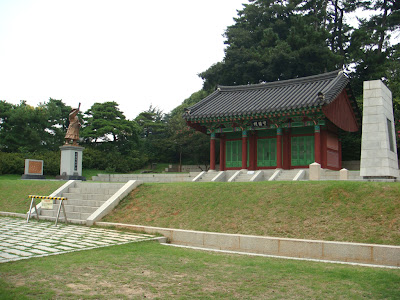
General Ahn Yong-Bok Shrine




Picture above shows the Jwasuyeong Fortress South Gate, also known as 주작문(朱雀門). Apparently, the two dog statues by the side is one of the kind and hardly found elsewhere.

This tree above is Natural Monument No. 311, in which is the Pujo tree stated on the signboard. What is so special about the tree? I will retype the information shown on the display board next to it.
Pseudo Hackberry (Celtis japonica planchon) in Suyeongdong, Busan
This giant tree is more than 500 years old. It is 18m in height, its trunk is 8.5m in circumference, and the branches spread 22.8m east to west and 18.5m north to south. There are several oddly-shaped lumps on the trunk. The villagers revere the tree as their tutelary, believing that it is inhabited by the spirit of a grandmother who protects them from evils. The pseudo-hackberry is a tall deciduos tree widely found int he middle and southern portions of the Korean peninsula. It has alternate ellipse-shaped leaves from 5cm to 10cm long, with saw-typed edges. Seven to twelve pairs of veins run to the final end of edges of the leaves. It blooms in May and its ball-shaped black fruits ripen in October and are covered with short downy hairs.水营洞 朴树
朴树属於榉树科,是落叶乔木,主要分布於中南部地方,这棵朴树树龄在五百年以上,村里的居民都把这棵树看得非常神圣,认为这棵树能保护村子的安宁和繁荣,把它认为是唐山木,或是地神木。

Finally, I'll show you a stone inside the park that describes the 8 beautiful sceneries of Suyeong.
Thursday 21 February 2008
History Buff
In my previous post, I have mentioned about some places of interest if you are into history. One city that has a lot of concentrated and accessible historic site, is none other than Gyeongju (경주 慶州). If you are in Busan, you can easily catch a bus and will reach Gyeongju in about an hour.

There are so many write up about Gyeongju, so I will just paste a couple of entrance tickets for reference.


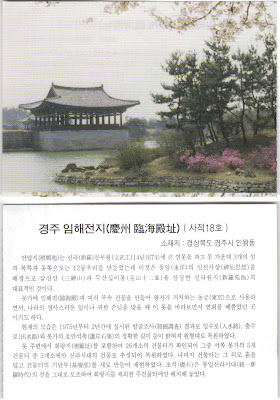

If you are into legend type of history, Jeju island old kingdom of Tamna founding legend is very interesting, at least to me. If you have time, do check it out Samseonghyeol. I don't think most tour package will cover this place, but do check it out as you can associate the story with places in around Jeju.

For modern history, I think Gwangju should not be missed, and I have to tell you, the images that you might see at the 5.18 Memorial can be shocking to some. What is the whole incident about? There is a 2007 movie called May 18, in which I have watched it in Gwangju itself, tells the story about this unfortunate event.
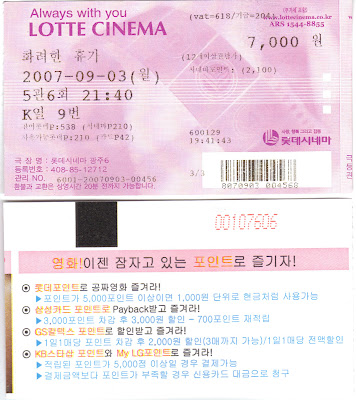
Also, if you are in Gwangju, do check out the nearby city of Damyang, the bamboo city. Rather nice scenery with everything that has to do with bamboo is just around the corner.
.jpg)
.jpg)
When in Damyang, don't forget to check out the Metasequoia Road, which is featured in the May 18 movie as well. Here's how the place looked like:

On the way back to Gwangju from Damyang, check out another historic site Sosoewon, the retreat for a scholar in those days. Rather picturesque, peaceful and calm. That explains why the poet rather be here than anywhere else.


Palace & Museum
I just love to visit museums, palaces, fortresses and so on. Some might not be top highlights on travel brochure, some might hardly make it on the brochure. I have done 4 out of 5 palaces in Seoul. Too bad that I missed one on my previous trip, and maybe I will complete my fifth in near future. So where did I go? I'll show entrance ticket as proof.




Entrance fees for these palaces are rather reasonable, except probably for Changdeok Palance, which you must really plan ahead, as the entrance fee and time varies depending on which section of the palace you want to go and when are you going. Confused? Guided tour is cheaper than self tour. Go figure. In order to help minimise any reader from this surprise, you can refer to the following picture taken at the counter for reference.




There are other palaces scattered around Korea, some of them are free, like the palace in Jeonju (전주 全州). Jeonju is really a nice place, and has nice bibimbap as well. The fortress gate nearby is open to public and you can go up as well. I'm not too sure whether they still allowed that now, after the incident of Sungnyemun.
Also, I have visited a couple of museums in Korea as well. Seoul National Museum is ok, since it is at the capital, but I think the best museum in Korea so far is Jinju Museum, which I think is rather cool that it is inside an old fortress. Gyeongju Museum is not too bad as well. So here's some of the museum I have visited.
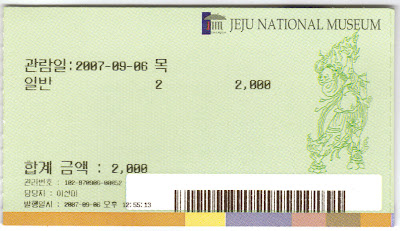




Wednesday 20 February 2008
Fast Food in Korea
I used to have a classmate in my Korean class stated that she didn't like Korean food that much. If you are someone like her, you can always opt for fast food, which is quite universal, except that it would have more localisation in menu. I'll show some popular franchise store found in Korea. Do note that Korea fast food outlet just like those found in Europe, you need to clean up after eating, plus you would need to pay for the bag if you plan to take away.
KFC 케이에프시
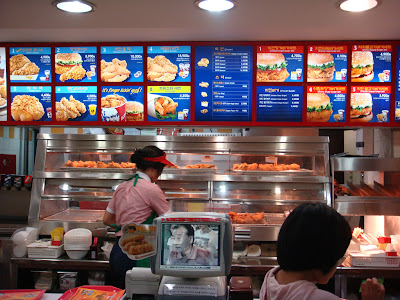
One thing good I found about Korea is that, they have very tasty and crispy fried chicken. Also in KFC, do try out the burgers, as their burgers are bigger than those we have in Malaysia, and quite popular among youngsters compared to just the regular fried chicken. Probably due to the fact that they have more fried chicken outlet in Korea compared to burger outlets.

How much does the meal above cost? Have a look at the receipt below. It's a set of ₩10,000 (with tax included), which was approximately RM37!!

McDonald's 맥도날드
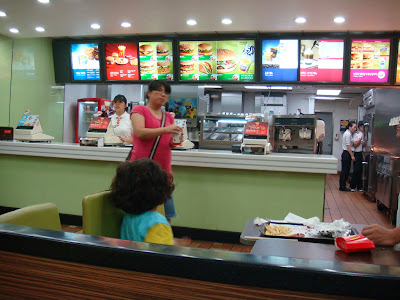
Korea McDonald's include the popular Bulgogi burger as the main local offering. You have the chance to taste burger with more choice of meat, such as pork or shrimp as well.
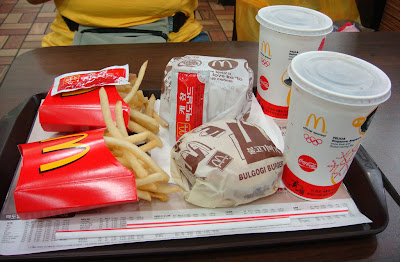
Most importantly, how much does it cost? Slightly cheaper at ₩9,000 including tax, which was approximately RM33.

Burger King 버거킹

This time around, I didn't eat inside the restaurant but I decided to take away. As you can see from the picture above, once you order, there is another line on the right to wait for your order.
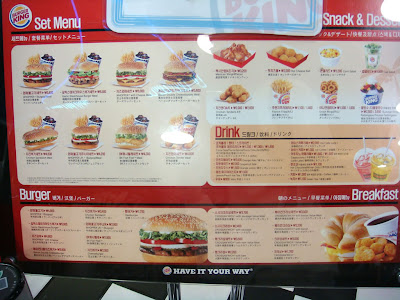
I have also taken a picture of the menu placed outside the restaurant. This particular outlet is just right outside the subway station.
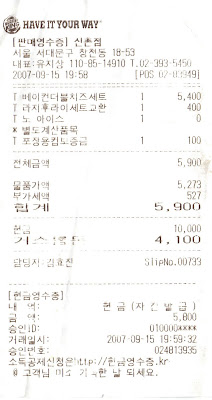
I had ordered only one set instead of two, since my sister didn't want any. And in the receipt you can see a ₩100 surcharge for the bag. So all in was ₩5,900, approximately RM21.
Lotteria 롯데리아

On a first glance, it looks similiar to McDonald's, with similar colour scheme, similiar food options. It was Japanese in origin but somehow has a Korean feel to it. More surprisingly, this outlet at Seoul Station is just next to McDonald's, which was hardly separated, i.e. no wall or glass in between the two outlets. No photos to show it unfortunately, you have to go and see it for yourself. Food portion was not as much as illustrated. Notice the paper spoon on the bottom right of the tray. Not really nice to scoop especially food with sauce.

Now, was it worth the money? You be the judge. Due to my limited Korean comprehension, I agreed without knowing exactly what the cashier told me to add on the corn salad for ₩100. So all in with tax was ₩7,600, approximately RM27.

Krispy Kreme 크리스피 크림

Since we do not have Krispy Kreme here yet in Malaysia, so it was rather a new experience, which I think was tastier than the other doughnut franchise we have in Malaysia. The outlet I have patronised was just a stone throw away from Busan Tower, which you can clearly see it in the picture.

The selection of doughnut was rather huge, thus when we stood for quite sometimes deciding what to take, I had a feeling we were blocking the other customers. Another thing about Krispy Kreme in Korea is that they gave a "service" of one original flavour doughnut for a single receipt purchase. "Service" in Korea means complimentary item, in which is given for free. Thus if you are the kiasu type, you can split your order into different receipt to receive as many "service" as you wish. But how was it? Let's have a look at my sister.

Looks like a satisfied customer, yeah? Probably that was the first time, it was really tasty and fresh from the oven really made the difference. We returned moments later to purchase a dozen to share it with friends. How much was it? ₩7,750, approximately RM28. Here's the receipt to illustrate the pricing. Notice that they charge the cup for beverages, as they encourage you to reuse the cup in future order. Cup of 16oz costed ₩50.

For those of you interested to know the menu and the price, here's a list I took when I was there.

